Text
Spoons in underwear

There’s a long history of kitchen implements being used to police or protect women’s bodies. In medieval and early modern times, for instance, women were supposedly sometimes subjected to virginity tests using a sieve.
Such was the mystique surrounding the idea of a woman being “sealed” prior to sex and “leaky” afterwards, which led to all kinds of quack medical connections being made between incontinence and sexual licentiousness, that a virgin woman was (again, supposedly) believed to be able to hold water in a sieve without it getting through the holes. Women survived this by exploiting the affordances of oil or wax to coat the sieve and invisibly stop up its holes. You can see a modified such test in Thomas Middleton and William Rowley’s 1622 play The Changeling – although it reverses the previous rhetoric by having virginity itself provoke verbal and nasal incontinence.
More recently, the kitchen knife has become the archetypal tool for women to kill abusive husbands. Winnie Verloc uses one to revenge herself on Mr Verloc in Joseph Conrad’s The Secret Agent. In 1996, in the case of R v Thornton, a woman who killed her husband was denied the defence of provocation, which requires instantaneous fury, because of the time and care she had taken to sharpen her kitchen knife. Her successful appeal helped establish the right of women who had spent years being abused to a defence on the basis of their resulting mental state.
Now, a British charity is telling girls who are at risk of being taken abroad for forced marriages – mostly to Pakistan, India or Bangladesh – to put spoons in their underwear in order to alert security staff at airports. This usually happens during the summer holidays, when schoolteachers are no longer in touch with the kids, and the victims are often told they’re going on holiday.The charity says the method has already saved some girls from being taken abroad.
This is a use of the combined affordances of metal and metal detectors, and an inversion of the usual procedure of airport security (which involves trying to strip all metal off your person), that I’m glad I haven’t had to consider before. It interacts in complicated ways with the usual valence of airport security as a site of anxiety and oppression for people of colour. Unfortunately, my partner tells me this is an old piece of advice that many South Asian girls of our generation grew up knowing.
0 notes
Text
Making a record from your ashes
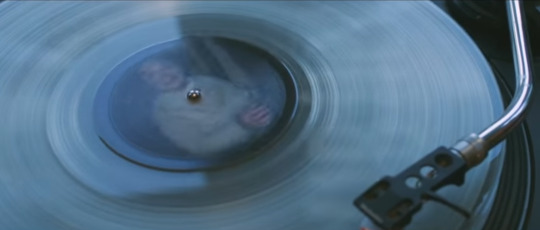
And I thought bone music was morbid. A British company is marketing records made from the actual ashes of your loved one at just $4,000 for 30. The obvious path is to record a voice message just before you die, saying how much you love the listener and will always be with them, and encode that.
This one’s a debatable “unusual use of objects” because it is an entire company offering a bespoke product which, you know, does what it’s advertised to. But I think it’s a particularly poignant, interesting use of human ashes – even if at first it may seem mawkish.
Vinyl records are among the most tactile forms of music recording. Like all recordings it involves a pattern of physical differences that are readable by a machine – in this case, grooves whose undulation is followed by a moving reader head. But here the pattern is so close to human scale: the grooves are tangible, their specific waves barely visible.

So there’s really something to the idea that a vinyl record of a dead person brings them back in a way an MP3 does not. People who love vinyl say they love it because of this physicality and warmth. As a child of the 1990s I’ve never felt it but I can understand it in abstract. The dead person’s voice is not only “vibrating you, the room, moving the air around you” (as the company’s founder says) but has frozen, congealed, into this wax thing you can feel with your fingertips. They have a new body now, pressed together from the remnants of their old one, simpler and smaller than what they had but more focused too. The undulations of their grooves are the wrinkles in their flesh. They have become a new pattern of affordance, hopefully one that they chose. That’s the essence of what I’m interested in here at Use of Objects.
Of course doing weird things with human ashes is an industry in itself. You can scatter them, keep them in urns, mix them into a concrete reef, get them tattooed onto you, send them to the moon, turn them into diamonds, turn them into fireworks, put them in an hourglass, or turn them into live ammunition ("I will rest in peace knowing that the last thing that one turkey will see is me, screaming at him at about 900 feet per second"). What these reveal, I think, is that the ashes of a human being may never have affordances quite as deep as those of a living human – or indeed a decomposing corpse – but they do span a wider variety of uses because of how fluid and unstructured they are.
Whatever a living human does, whether it’s flying a plane or building the Timurid Empire, the body must retain its composition and integrity. Ashes by comparison are fluid and unstructured. In that sense cremation really is a liberation from embodiment. We become flexible and fungible, like water or like money.
Hat tip to Stephen Beirne for this one.
0 notes
Text
Play-doh

We’re not just about “subversive” anti-authority activity here at Use of Objects – oh, no. Corporations are people too, my friends, and many a "brand story” involves customers discovering a hidden, secondary affordance which later becomes a primary selling point.
Play-Doh was originally invented in the 1930s as a wallpaper cleaning product. It was made by a Kutol, a soap company in Cincinnati, on commission from the midwestern grocery giant Kroger. At that time most American houses were heated by coal, and you could use a wad of this squishy soapy stuff to remove soot from your walls. By the 1950s, though, more and more houses were heated using natural gas, and most wallpaper was now vinyl-coated, so Kutol killed the product.
But Kutol’s head had a sister-in-law, Kay Zufall, who was a nursery school teacher in New Jersey. Zufall needed a cheap way for her kids to make Christmas decorations, and she had seen a newspaper article about people making art out of wallpaper cleaner. Kutol’s product was perfect: squishy but held its shape, kneadable yet cutable, and it was also non-toxic (and kind of tasty, according to my memories). She convinced her brother-in-law to relaunch the stuff as a toy for kids, and the rest is cute commercial history.
0 notes
Text
Bone music
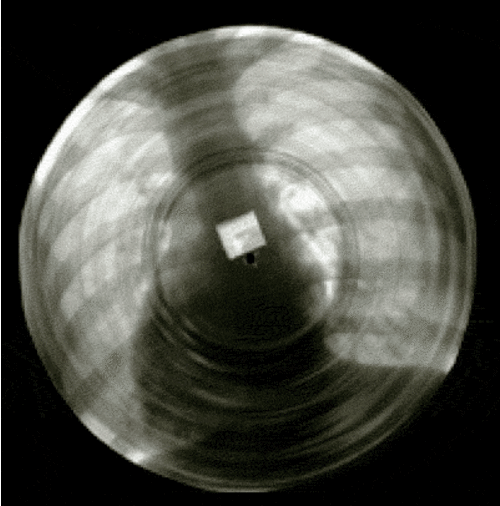
In the Soviet Union in the 1950s and 1960s, a lot of Western popular music was banned or not produced. Obviously some people still wanted to listen to it, so they produced bootleg recordings which were played and exchanged between friends in private kitchens. But in a state-controlled economy it was difficult to get the vinyl to make records.
The solution came from Ruslan Bogoslowski, who found you could make cheap records using old X-Ray exposures salvaged from hospital bins or wheedled from hospital employees in exchange for some favour. Bogoslowski was later imprisoned, and his method was officially banned in 1958, but it had already caught on, and the gloriously creepy records became known as "ribs" (ryobra) or "bone music". The podcast 99% Invisible has a great episode about them here.
Incidentally, the Soviet phenomenon of the “dissident kitchen”, where such records often circulated, was a subversive use of objects too (or a counter-revolutionary hooligan saboteur use of objects, if you like). When Nikita Kruschev became First Secretary of the Communist Party in 1953, many people still lived in cramped apartment complexes with communal kitchens, and one of his projects was to give everyone their own. Suddenly millions of people had a new private space, free from nosy neighbours and most state surveillance. With the tap running to drown out noise and a pillow over the phone, kitchens became sites of discussion, debate and resistance. The provision of a new material feature intended to make citizens’ lives more comfortable had also unintentionally made them harder to police. To this day Russians refer to political bloviation as “kitchen table talk”.
1 note
·
View note
Text
Coca-Cola advertising

In January 2016 the Coca-Cola company released an online tool called “GIF the Feeling” which allowed users to create their own Coca-Cola adverts using a library of pre-selected Coke gifs. So naturally Daniel Joseph, a doctoral student in Canada writing about videogames and labour who blogs at @dropouthangoutspaceout, started trying to figure out how he could turn their tool towards frivolous critiques of capitalism itself.
But of course Coca-Cola made this tool for a purpose, and they had taken steps to ensure nobody used it for anything else. A word filter took the sting out of critique by banning the word “capitalism” as well as “communism”, profanity, and terms relating to death.
A spokeperson said:
“Our intention is to invite people to share their feelings in a positive and uplifting way as they discover our new ‘Taste the Feeling’ campaign. We have safeguards in place including filters and moderation to help ensure ‘GIF The Feeling’ is being used for its intended purpose.”
Happily, it was relatively easy to circumvent, creating this image of the business world running gaily into future climate catastrophe.

Deliberately subvering adverts is a well-worn practice by now; theorists and boosters call it culture jamming. As with so many things (eg Pokemon Go) it grows out of French situationism, in this case the notion of detournement, or “hijacking”. A detournement is a variation on a previous work whose meaning is oppositional to that of the original, and the archetypal example is a prank that defaces an advert. Many actual examples of this are of course boring and stupid (COUGH banksy COUGH). Crude corporate attempts to limit detournement are de rigeur (see Buzzfeed founder and Deleuze enthusiast Jonah Peretti’s email chain with Nike when he tried to order custom trainers with “sweatshop” written on them), as is leftist debate about whether any of this is actually subversive or simply a fantasy of rebellion etc etc.
Beyond this there is the more genuinely anarchic thing which happens whenever anyone creates a tool for mass public use. The determination of people in general to hack and break and repurpose almost any tool which comes their way is a kind of playful correlate of Linus’ Law (”given enough eyeballs, all bugs are shallow”) – though being a former humanities student rather than a comp sci guy I believe that social and cultural biases and blindnesses create massive variations in the extent to which that law applies. Anyway, of course thousands of people will have done whatever they can with Coca-Cola’s tool, just because.
These dynamics often combine. Where a company or authority attempts to interact with the public it’s now very common for people to take that interaction and transform it into a space where they can oppose and critique its owners. This famously happened with the #myNYPD hashtag and used to regularly happen to the regular #askBoris Twitter sessions run by former London mayor Boris Johnson.
But the particularly fun thing here I think is the texture of what Coca-Cola chose to censor. Ian Bogost systematically probed GIF the Feeling and found it banned jeez, heck, and hell; cocaine, heroin, beer, and cigarette; fellatio, head, sex, bikini, and even (replicating the persistent issue of dumb content filters blocking innocent queer content) bisexual; liberal, conservative, infidel, Christ, caliphate, black, and white; Pepsi, 7UP, Google, Android, Diderot, Cosby, and Nirvana; murder, death, slaughter, stalking; dementia, itch, and diabetes; lard, celery, coffee, caffeine, caramel; and a grab bag of strange terms such as peasant, junket, gizmo, perky, and divergent.
This necessarily constitutes an unusually comprehensive if bizarre statement of everything Coke considers unacceptable in its adverts. It is, as Bogost says, an “apophatic brand position”, which “tells us everything Coke thinks it isn’t”. It’s a perfect example of oppositional usage revealing qualities of the object being used: in this case, the exact shape of its superego.
But then, is this really an oppositional usage? Bogost concludes that all of this play and “subversion” still ultimately serves the purpose of promoting Coca-Cola and is captured by its needs. In fact he makes a good argument that this tool was much less vulnerable to oppositional use than the public-square-style #askBoris type hashtags. If so then Coca-Cola’s list of banned terms is not the amusingly exhaustive obsession of a neo-Victorian prude but merely damage limitation by a company which, like a submissive partner who could switch her role mid-fuck but chooses not to, knows exactly what is going on, and has priced that in.
#detournement#technology#Coca-Cola#capitalism#corporations#Ian Bogost#Daniel Joseph#censorship#filters
1 note
·
View note
Text
The Hitachi Magic Wand
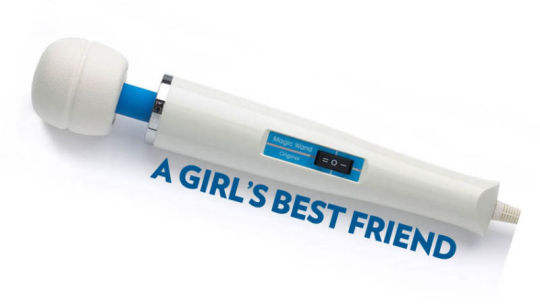
I tremble in the presence of an icon. The Hitachi Magic Wand, first patented in the US in 1968, was registered with the FDA, and advertised, as a massage device, intended for relieving sore muscles and aches, and its makers have repeatedly reaffirmed that it is solely for medical use. It is not, I repeat, not intended or authorised for use as a sex toy. Do you understand?
Well, as the sex educator Betty Dodson put it, “tough shit”. Since its genesis in the year of the student revolution, the death of Martin Luther King, and the Tet Offensive, the Hitachi’s has become one of the first world’s most famous sex toys (“cadillac of vibrators” and all that). For 1970s sex positive feminists it was a key tool for teaching women how to enjoy sex. In one study 93% of chronically anorgasmic women were able to orgasm with its aid; it has also seen use treating myalgia, proprioceptive issues, and as a safe anaesthetic for newborns. It was immortalised for previous generations by Samantha on Sex and the City and for me by Porpentine’s text adventure game How to Speak Atlantean. Its Wikipedia page is seriously a pretty good document of American social history.
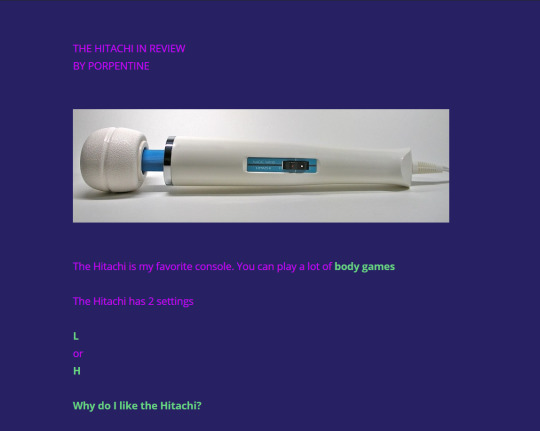
As with cotton buds, I have severe doubts that this “unintended” use is actually unintended. Supposedly the company is run by “traditional” people and is nervous about having its name on a sex toy. But it’s not ridiculous to imagine that Hitachi is simply engaging in the mother of all deniable operations. They must realise by now who their customer base really is. If ya don’t know, now ya know.
Indeed, Hitachi has had an ambiguous and shifting relationship to its blockbuster product: in 1992 they helped pay for Magic Wand shaped chocolates devised as a promotion for a sex shop, but in 2013 they actually took their name off the product and began selling it through an intermediary, Vibratex, as the Original Magic Wand (accept no substitutes!). "Clearly, [the Magic Wand] is a straightforward product. There are no implications of anything beyond standard health-care use,” said a spokesman in 1999. Clearly!
But there are also reasons to think it really wasn’t meant for sex, at least at first. For one thing, 1968 is a long time ago. For another, the Magic Wand is pretty unusual among vibrators, and to my eyes oddly primitive. It has a 2.5 inch wide head coated in a rubber casing which rocks backwards and forwards with rapid frequency. A wide range of third party attachments are available to modify the shape of this head, but by default it’s a bit like someone softly punching you repeatedly and at high speed. It has no batteries and instead plugs into a wall socket. It is therefore famously strong without being overwhelming.
A study in the Scientific World Journal in 2008 said it was particularly good for orgasm-blocked people because it created sensation “without superficial discomfort”. I think that's linked to what Porpentine says, that it "decentralizes genitalia in favor of a vibrating hub". The sensation is spread across a wide area by the large head, and that makes it less intimidating. It’s also really good for trans people because it (and its genderless, quasi-medical packaging) make so few assumptions about your genitals and what you want done to them. And it’s good for people who have limited use of their hands because it’s big and has a long handle.
it might be that these qualities would not have been designed into a vibrator which was intended as a vibrator. It might in fact be that the qualities which have made it so popular – its power, its seeming safety, its large surface area – are qualities it only has because it was designed as a muscle massager.
I don’t know enough about the history of vibrator design to say this for sure, but it seems possible to me that many other vibrators might be designed, if not by men, then according to patriarchal assumptions about what women want (or just innocent but wrong assumptions by very sex-positive designers about what less confident and adventurous women might want!). I often think about this Tumblr post:
me: i want something very short and small and cutesy but most importantly body safe and discreet
sex toy companies: try the DEVASTATOR SEVENTY THREE INCHES OF PURE JELLY RUBBER HYPER REALISTIC VEINS WE SHOWED IT TO A NUN ONCE AND SHE BURST INTO FLAMES THERE’S ONLY ONE SETTING: DEVASTATION THE VIBRATIONS CAUSED AN EARTHQUAKE MILLIONS ARE DEAD
Maybe the Magic Wand actually had to be designed with non-sexual affordances in order to glitch its way past our assumptions about what sexual affordances should be.
0 notes
Text
Cotton buds

Did you know that you are not supposed to use cotton buds to clean earwax out of your ear canals? The makers advise against it, and studies show it can be dangerous. And yet I’d bet that in the vast majority of instances where cotton buds are used, they are used for ear cleaning.
This is a fun example where the ‘unauthorised’ usage of an object is actually its primary usage. We might call it demotic repurposing. Cotton buds – which apparently were originally termed “baby gays” ¯\_(ツ)_/¯ – are obviously useful for other things like removing make-up. But their form seems almost perfectly designed for insertion into ear canals too. That form interacts with a strange conviction we humans have that earwax is undesirable, and the strange satisfaction we take in clearing it all out, to create a state of affairs in which between 1990 and 2010 an estimated 263,338 American children went to hospital emergency rooms for cotton bud related injuries.
The bud form is so perfect for ear-picking that I actually suspect there might be some deception here. i.e. the cotton bud wasdesigned to clean out earwax and the companies knew it would be good for that, but they didn’t want to recommend it for that in case they get sued. Hence the great fiction which we all for whatever reason uphold that this is not their intended purpose.
Thanks to Rowan Kaiser for submitting this object.
0 notes
Text
Hard drive music
youtube
Ye olde computers were noisy as fuck. Anyone who connected to the internet in the era of 56k will remember the eerie shriek of a modem connecting to the network. And as disc-based hard drives are replaced by solid state devices, it may become hard to exactly describe the tension and trepidation that came from hearing the telltale clicking or buzzing noise which indicated that your computer was drawing data from the former.
You could hear the computer thinking, which meant that something was about to change – whether that meant a total crash on a dodgy machine always teetering on the edge of breakdown or a brutal response by an AI opponent in a turn-based strategy game. It was the sound of an input making a difference, heard before you knew what the difference would be: the sound of dice clicking across a table.
Anyway, obviously you can make music out of that sound. These hard drives store data on aluminium discs, which are read and written to by a moving head similar to that of a record player. Its movement, and (I think! someone correct me) its occastional contact with the discs is what makes that noise. So of course you can set it up to move over the disc in specific patterns and frequencies which produce the sounds of music.
On Youtube you can find lots of songs, modern and classical, covered by arrangements of multiple hard drives and floppy disc drives tuned to play the parts of different tracks. The sounds have a crude quality but not necessarily a bad one. It has the feeling of a robotic car assembly plant becoming sentient and performing symphonies as best it can when the human workers have gone home for the night.
youtube
9 notes
·
View notes
Text
Sabotage and clog dancing
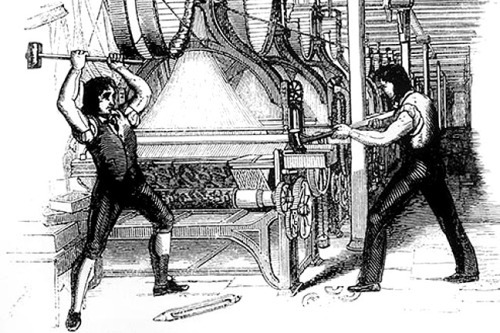
The word “sabotage” comes from the French word “sabot”, meaning a wooden shoe of the kind worn by many workers during the Industrial Revolution to protect their feet. And there is a long-running folk etymology that it refers to striking workers literally throwing these shoes into machines to shut down their factories.
This is an amazing idea, but it’s probably not true. Still, in England clog-wearing workers did find a new use for their industrial equipment: clog-dancing.

According to Wikipedia:
“English clog dancing began in 19th century England during the Industrial Revolution. It is thought to have developed in the Lancashire cotton mills where wooden-soled clogs were preferred to leather soles because the floors were kept wet to help keep the humidity high, important in cotton spinning. Workers sitting at the weaving machines wore hard-soled shoes, which they would tap to the rhythms of the machines to keep their feet warm. At their breaks and lunches, they would have competitions, where they were judged on the best rhythm patterns. By the late 1800s they clog-danced on proper stages at competitions.”
Perhaps this could still be a form of wrecking if their bosses disapproved of the practice. I suspect instead it was generally supported as an equivalent to modern team-building exercises.
0 notes
Text
Introduction

“The street finds its own uses for things.”
William Gibson, Burning Chrome
All objects have affordances – a range of things which their material characteristics make it possible to do with them. We can think of these affordances as forming a ‘possibility space’ defining and containing everything we can do with the object. There are degrees of possibility too: with a rake it is easy to collect leaves, and hard to caress.
But humans never have total knowledge of all an object’s affordances. And we’re extremely good at finding new regions of an object’s possibility space which its designers or frequent users didn’t know were there. A rake can also be used as a weapon, a moveable post to lean on, a comedy trap for the unwary, or indeed, precisely for caressing.
This is a blog devoted to collecting strange, hidden, surprising, unintended, or unauthorised uses of objects. It is predicated on the certainty that every object that exists has some use not everyone is aware of, and probably some uses that nobody is aware of. In science, love, politics, and life, finding these uses – and going beyond the uses that we are initially taught – is the key to our happiness, creativity, and liberation. For anything can be an object, and no object has just one use.
Note: I don’t want to get too hung up on what counts as “unintended” or “unauthorised” use, nor “strange” and “hidden”. Different uses can be strange to different people, or hidden to some while obvious to others; intention and authority flows in complex ways between individuals and across groups, while sometimes being absent (as with rocks and trees). I’m interested in these complexities, but I’m not interested in ruling any given use definitively authorised or subversive, just as I’m not interested in ruling any use to be good or bad. These words are intended as starting points for contemplation, not as rules to be lawyered over.
This is a project by John Brindle. Please do submit your own strange uses to fao DOT john DOT brindle AT gmail.com. You will be credited, unless you’d like to be anonymous.
0 notes